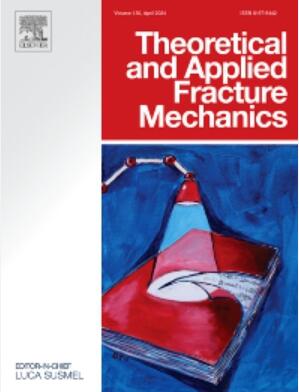Impact of various fibers on mode I, III and I/III fracture toughness in slag, fly Ash, and silica fume-based geopolymer concrete using edge-notched disc bend specimen
IF 5
2区 工程技术
Q1 ENGINEERING, MECHANICAL
引用次数: 0
Abstract
There is ongoing research aimed at developing cement-free concrete that not only exhibits enhanced mechanical properties but also incorporates environmentally sustainable materials. Geopolymer represents a novel inorganic cementitious material recently developed, which facilitates utilising resources derived from solid waste from industrial operations. Geopolymer is considered an ecologically sustainable substitute for Ordinary Portland cement. It significantly reduces energy usage and minimizes carbon dioxide emissions, contributing to environmental sustainability. This study investigates the combined influence of granulated blast furnace slag, fly ash and silica fume on geopolymer concrete (GC) fracture resistance. This research aims to assess the fracture toughness of GC under modes I, III, and I/III loading conditions. Four distinct fiber types, comprising both short and long steel fibers and polypropylene fibers at 1.5 % dosage, were utilized to mitigate brittleness and enhance the ductility of the material. In addition, the microstructure of GC was analysed using X-ray diffraction and scanning electron microscopy. Findings reveal that the inclusion of short and long polypropylene fibers in GC increased mode I fracture toughness by 20.98 % and 29.62 %, respectively, compared to the fiber-free specimen, with long fiber showing superior performance due to its enhanced crack-bridging ability. Steel fibers provided a more pronounced improvement, with short and long fibers increasing mode I fracture toughness by 77.77 % and 109.87 %, respectively, attributed to their capacity to hinder crack propagation and enhance fracture toughness. The long fibers exhibited an excellent fracture resistance than the short fibers and mode III is more critical than the mode I loading.
利用切边圆盘弯曲试样,分析各种纤维对矿渣、粉煤灰和硅灰基土工聚合物混凝土中 I、III 和 I/III 型断裂韧性的影响
目前正在进行的研究旨在开发无水泥混凝土,这种混凝土不仅具有更强的机械性能,而且还采用了环境可持续材料。土工聚合物是最近开发的一种新型无机胶凝材料,它有助于利用从工业生产中产生的固体废弃物中提取的资源。土工聚合物被认为是普通硅酸盐水泥的生态可持续替代品。它大大降低了能源消耗,最大限度地减少了二氧化碳排放,有助于环境的可持续发展。本研究调查了粒化高炉矿渣、粉煤灰和硅灰对土工聚合物混凝土(GC)抗断裂性的综合影响。该研究旨在评估土工聚合物混凝土在模式 I、III 和 I/III 加载条件下的断裂韧性。研究采用了四种不同类型的纤维,包括长短钢纤维和聚丙烯纤维(用量为 1.5%),以减轻脆性并增强材料的延展性。此外,还使用 X 射线衍射和扫描电子显微镜分析了 GC 的微观结构。研究结果表明,与不含纤维的试样相比,在 GC 中加入短聚丙烯纤维和长聚丙烯纤维可使模式 I 断裂韧性分别提高 20.98% 和 29.62%,其中长纤维因其增强的裂缝桥接能力而表现出更优越的性能。钢纤维的改善更为明显,短纤维和长纤维分别将模态 I 断裂韧度提高了 77.77 % 和 109.87 %,这归功于它们阻碍裂纹扩展和提高断裂韧度的能力。与短纤维相比,长纤维表现出更出色的抗断裂性,而模式 III 比模式 I 载荷更为关键。
本文章由计算机程序翻译,如有差异,请以英文原文为准。
求助全文
约1分钟内获得全文
求助全文
来源期刊

Theoretical and Applied Fracture Mechanics
工程技术-工程:机械
CiteScore
8.40
自引率
18.90%
发文量
435
审稿时长
37 days
期刊介绍:
Theoretical and Applied Fracture Mechanics'' aims & scopes have been re-designed to cover both the theoretical, applied, and numerical aspects associated with those cracking related phenomena taking place, at a micro-, meso-, and macroscopic level, in materials/components/structures of any kind.
The journal aims to cover the cracking/mechanical behaviour of materials/components/structures in those situations involving both time-independent and time-dependent system of external forces/moments (such as, for instance, quasi-static, impulsive, impact, blasting, creep, contact, and fatigue loading). Since, under the above circumstances, the mechanical behaviour of cracked materials/components/structures is also affected by the environmental conditions, the journal would consider also those theoretical/experimental research works investigating the effect of external variables such as, for instance, the effect of corrosive environments as well as of high/low-temperature.
 求助内容:
求助内容: 应助结果提醒方式:
应助结果提醒方式:


